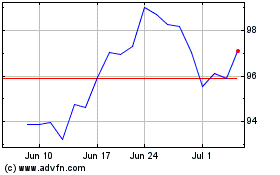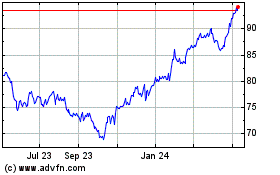Stocks in the Consumer Staples sector have traditionally performed
better than the stock market, and especially cyclical companies,
during market declines. We are seeing evidence of this at present
-- consumer staple stocks have started shining again as concerns
about the economy’s growth momentum have taken center stage.
The fundamental explanation for this behavior is that food,
beverage, household products and cosmetics companies manufacture
and market brand name consumable products, most of which are
considered essential to daily life, such as food, drink,
toothpaste, deodorants, toilet paper, etc.
Since product demand is relatively stable, the companies generally
report earnings in line with expectations.
Beverage companies, however, are able to grow faster at the high
single-digit to low double-digit rate given growing penetration
rates. But, cosmetics companies can grow earnings a percentage
point or two above beverage companies, because they are able to
differentiate their products.
Past Performance
In 2009, the Consumer Staples sector underperformed the market as
stocks had started discounting the recovery out of the Great
Recession. In 2010, the sector index grew 10.7% versus a 12.8%
increase for the S&P 500 index.
Given the less than clear macro-backdrop at present, the group has
again come into favor, helping it do better than the rest of the
market. The defensive profile of consumer staples makes it an
attractive refuge in uncertain times like the present ones.
Road Ahead
As referrred to earlier, the macro-economic environment remains
uncertain. With consumer spending under pressure, as reduced state
and municipal spending and high gas prices offset the benefits from
the payroll tax cut. As a result, domestic retail revenue growth is
expected to remain relatively modest.
Further, the unemployment level in the U.S. is expected to remain
high much longer than appeared to be the case a few months ago, as
indicated by the disappointing May non-farm payroll report. In this
environment, less expensive private label goods are expected to
attract consumers, thereby limiting the growth potential of branded
food companies.
Further, the substantial rise in raw material prices remains a drag
on margins of most of the companies in this sector. We have seen
this trend with
Colgate Palmolive (CL),
Kimberly-Clark (KMB) and
Procter &
Gamble (PG) in recent days.
However, among soaring prices of raw materials and high levels of
unemployment, there still seems to be some opportunity for
companies under the consumer staples sector to cash in on. Growing
awaress of issues like obesity and cardio-vascular diseases has
prompted consumers to seek out healthier alternatives that have
fewer calories and less sugar and sodium.
Many companies in the group, such as
Campbell Soup
Company (CPB),
PepsiCo (PEP) and
The Coca Cola Company (KO) have come out with
products to tap this market demand. Similarly, even companies
operating in the household products category such as Procter &
Gamble and Colgate Palmolive bring out new innovative products to
cater to the ever-changing demands of customers.
Health, beauty and other products targeted at Baby Boomers also
remain well positioned. Products that help this generation look or
feel younger may thrive as many Baby Boomers seek to continue
working beyond the traditional retirement age. Companies such as
Avon Products (AVP) and
Unilever
(UL) are constantly introducing new products especially targeted at
young women.
In the mass retail space, the top and bottom tiers are doing fine,
though the mid-market segment has remained under pressure. Among
discounters,
Dollar General (DG) opened 600 new
stores last year and is expected to repeat this in fiscal 2011.
Similarly,
Family Dollar Stores (FDO) has
announced that it will increase its rate of new store openings by
50% and plans to open 300 new stores in 2011, while
Supervalu (SVU)-owned Save-A-Lot has announced
plans to double its store network by 2015, which would take its
total network to 2400.
OPPORTUNITIES
We are more or less Neutral on the stocks in this sector. Though
temporarily impacted by inflation, these companies are cash rich
and can withstand the current economic headwinds.
Procter
& Gamble (PG) is one of the strongest and most
financially sound companies in the consumer staples sector. The
company generated approximately $3.2 billion in free cash flow with
a free cash flow productivity of 113%.
Although the global market growth was a meager 3% for the most
recently reported quarter, Procter & Gamble continues to see
healthy growth rates in developing markets in the range of 6% to
8%. However, margins were impacted by higher commodity costs.
Higher commodity costs compared with the year-ago quarter led to a
200 bp margin contraction in the last quarter.
In the most recent quarter, global net sales of
Colgate
Palmolive (CL) increased 4.5% year over year to $4.0
billion despite a 3% benefit from foreign exchange and a 2%
addition from global unit volume, which was offset by a 0.5%
decline in pricing.
On an organic basis (excluding foreign exchange, acquisitions and
divestitures), sales increased 1.5% in the quarter, with gross
profit increasing by 2.8% to $2.3 billion. Gross profit margin
declined by 80 basis points to 58.4% compared with the prior-year
quarter, as higher material costs and steep promotional investments
undid the benefits of cost-saving initiatives.
WEAKNESSES
Kimberly-Clark (KMB) is one of the world’s leading
manufacturers of health and hygiene products, and commands a strong
portfolio of well-established brands. In the most recent quarter,
the company reported lower than expected results. The margins were
also impacted by higher costs of raw materials.
Further, the company assumes inflation to be in the range of $450
million to $550 million. The increased inflation assumption is
primarily due to higher costs for virgin pulp, polymer resin and
most other oil-based materials. Although, on a long term basis we
are Neutral on the stock, on a short term basis the stock has a
Zacks #4 Rank which implies a Sell rating on the stock.
Altria Group (MO) reported modest results for the
first quarter of 2011. Although earnings grew 4.8% year over year,
it was in line with the Zacks Consensus Estimate.
Further, revenues also contracted 2.0% to $5.6 billion. The decline
was attributable to lower net revenues from cigarettes and cigars,
partially offset by higher net revenues from smokeless products,
financial services and wine. Excluding excise taxes, revenues were
flat year-over-year at $3.9 billion.
Management at Altria stated that the business environment for 2011
is expected to remain challenging. This is because adult consumers
remain under economic pressure and face high unemployment. In
addition, Altria’s tobacco operating companies also face a number
of challenges as they enter 2011.
AVON PRODS INC (AVP): Free Stock Analysis Report
COLGATE PALMOLI (CL): Free Stock Analysis Report
DOLLAR GENERAL (DG): Free Stock Analysis Report
FAMILY DOLLAR (FDO): Free Stock Analysis Report
KIMBERLY CLARK (KMB): Free Stock Analysis Report
COCA COLA CO (KO): Free Stock Analysis Report
ALTRIA GROUP (MO): Free Stock Analysis Report
PEPSICO INC (PEP): Free Stock Analysis Report
PROCTER & GAMBL (PG): Free Stock Analysis Report
SUPERVALU INC (SVU): Free Stock Analysis Report
UNILEVER PLC (UL): Free Stock Analysis Report
Zacks Investment Research
Colgate Palmolive (NYSE:CL)
Historical Stock Chart
From May 2024 to Jun 2024

Colgate Palmolive (NYSE:CL)
Historical Stock Chart
From Jun 2023 to Jun 2024
